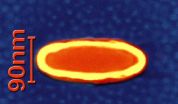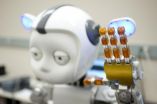(Press-News.org) According to rough estimates, there are some 20,000 undiscovered archaeological sites in Israel waiting to be explored. Currently buried under highways or beneath cities, some could reveal historic monuments from the biblical past and give us clues to the expansion and settlement of modern man as he made his way through the Fertile Crescent.
But where to begin? Who decides which sites should be "dug" — at considerable financial cost — and which should remain unexplored until a later date? A new tool from Prof. Lev Eppelbaum of Tel Aviv University's Department of Geophysics and Planetary Sciences at the Raymond and Beverly Sackler Faculty of Exact Sciences may provide the answer.
Prof. Eppelbaum's new tool combines advanced analyses from many geophysical methods and provides the most conclusive evidence ever produced about what's below the ground's surface. His tool is already being applied at many archaeological sites in Israel — and it's ready to be used in the United States and at other sites around the world.
An overland use for nuclear submarines
Reported recently in the journal Advances of Geosciences, Prof. Eppelbaum's new tool gathers data from a number of sources — including radio transmitters used to communicate with nuclear submarines and detailed magnetic field observations — and applies an original algorithmic approach to the measurements to make sense of what lies below the earth's surface at depths of up to several dozen yards. His tool can help people "see" meaningful objects, artefacts or civilizations –– and lay them out in a four-dimensional chart.
While methods exist for scanning sites of potential archaeological and geological importance, such tools produce significant background noise or inconclusive readings, Prof. Eppelbaum says.
"Inspired by Israel, where we have so many archaeological records underfoot, my tool can also help Americans locate old native burial grounds, and determine minerals and elements several yards below the surface," he continues.
A faster road into the past
His tool can be used to evaluate the possible archaeological significance of any given area under scrutiny. Providing rapid results within days or even hours, the algorithm can "read" extensive data before any digging or exploration begins. Financially, technically and ecologically, this tool offers an optimal way to localize and classify ancient buried objects and estimate the potential of the further archaeological investigations, he says.
Prof. Eppelbaum's solution is called the "multi-PAM," which stands for "physical–archaeological models." The tool first interprets what it "sees" by recognizing image targets; then the interpretation can be used to develop a four-dimensional model which can be presented to archaeologists hoping to explore a particular region.
Placed in a small unmanned airplane hovering several yards off the ground and scanning wide tracts of land along the earth's surface, Prof. Eppelbaum says, the tool can reveal unexplored sites of historical and archaeological significance.
###
Prof. Eppelbaum's work currently receives grants from USAID, NATO and Framework 7 in the EU.
American Friends of Tel Aviv University (www.aftau.org) supports Israel's leading, most comprehensive and most sought-after center of higher learning. Independently ranked 94th among the world's top universities for the impact of its research, TAU's innovations and discoveries are cited more often by the global scientific community than all but 10 other universities.
Internationally recognized for the scope and groundbreaking nature of its research and scholarship, Tel Aviv University consistently produces work with profound implications for the future.
Scanning antiquity underfoot
Tel Aviv University researcher develops geological tool to see what's below the ground's surface
2011-03-09
ELSE PRESS RELEASES FROM THIS DATE:
New bowel cancer evidence calls for routine DNA repair test
2011-03-09
Bowel cancer patients whose tumors contain defects in specific DNA repair systems are much less likely to experience tumour recurrence post surgery, results from a major clinical study have demonstrated.
Scientists who collaborated on the 10 year QUASAR randomised control trial, one of the largest UK clinical trials to test the benefits of chemotherapy in post-surgery bowel cancer patients, have confirmed that colon tumors containing defects in their DNA mismatch repair system are 50 percent less likely to recur following surgery compared to tumors where DNA mismatch ...
Malaria's weakest link
2011-03-09
A group of researchers from EPFL's Global Health Institute (GHI) and Inserm (Institut National de la Santé et de la Recherche Médicale, the French government agency for biomedical research) has discovered that a class of chemotherapy drugs originally designed to inhibit key signaling pathways in cancer cells also kills the parasite that causes malaria. The discovery could quickly open up a whole new strategy for combating this deadly disease.
The research, published online in the journal Cellular Microbiology, shows that the malaria parasite depends upon a signaling pathway ...
Study: Homeless patients cost $2,500 more than the average patient for each hospital stay
2011-03-09
TORONTO, ON., March 8, 2011—Homeless patients cost about $2,500 more per hospital stay than the average patient, according to a new study by researchers at St. Michael's Hospital.
Homeless people with medical or surgical problems arrive at the hospital with underlying health issues and stay longer than others, often because there is no place to send them after their initial medical crisis has been treated, the study found. Those with psychiatric illness arrive at the hospital much sicker than others.
The findings suggest the cost of hospitalizing people who are homeless ...
Extremely fast MRAM data storage within reach
2011-03-09
This release is available in German.
Magnetic Random Access Memories (MRAM) are the most important new modules on the market of computer storage devices. Like the well known USB-sticks, they store information into static memory, but MRAM offer short access times and unlimited writing properties. Commercial MRAMs have been on the market since 2005. They are, however, still slower than the competitors they have among the volatile storage media. An invention made by the Physikalisch-Technische Bundesanstalt (PTB) changes this situation: A special chip connection, in association ...
How can robots get our attention?
2011-03-09
Getting someone's attention can be easy with a loud noise or a shout, but what if the situation calls for a little more tact? How can a robot use subtle cues to attract a human's notice and tell when it has captured it? In a preliminary study, researchers at the Georgia Institute of Technology have found that they can program a robot to understand when it gains a human's attention and when it falls short. The research is being presented today at the Human-Robot Interaction conference in Lausanne, Switzerland.
"The primary focus was trying to give Simon, our robot, the ...
Earth: Alive -- bacteria back from the brink
2011-03-09
Alexandria, VA – In 1993, "Jurassic Park" thrilled the world with the idea that dinosaurs could be resurrected from bits of DNA preserved in mosquitoes trapped in ancient amber. In the 18 years since the movie came out, scientists have been finding that parts of this scenario are closer to reality than anyone ever imagined: Researchers have found microbes living for tens of thousands - and maybe millions - of years inside salt crystals.
These findings raise exciting questions, as EARTH explores in "Bacteria Back From the Brink" in the April issue. Could these hibernating ...
Eating disorders and body dissatisfaction is double in Muslim teenagers than in Christian
2011-03-09
This release is available in Spanish and French.
The incidence of eating disorders was found to be 2.3-fold higher among Muslim adolescents than among their Christian classmates. Similarly, body dissatisfaction was 1.8-fold higher in the former group. Finally, as a general conclusion, an average of one in four adolescents suffers some type of eating disorder, and 15% suffers body dissatisfaction. These were the conclusions drawn of a research conducted at the University of Granada.
The sample was taken from a Spanish multicultural city, Ceuta, where different religious ...
Migrating moths and songbirds travel at similar rates
2011-03-09
A study published today (09 March) in Proceedings of the Royal Society B by researchers at Rothamsted Research (an institute of the Biotechnology and Biological Sciences Research Council), and the universities of Lund (Sweden), Greenwich and York, reports the surprising finding that night-flying moths are able to match their songbird counterparts for travel speed and direction during their annual migrations but they use quite different strategies to do so - information that adds to our understanding of the lifestyle of such insects, which are important for maintaining ...
University of South Florida researchers find blood-brain barrier damaged by disease
2011-03-09
A study into the effects of Sanfilippo Syndrome type B (MPS III B) has found that the barrier responsible for protecting the brain from the entry of harmful blood-borne substances is structurally and functionally damaged by the devastating disease. University of South Florida researchers identified damage in specific brain structures involved in the pathology of MPS III B, one of four Sanfilippo syndromes, all of which are inherited diseases of metabolism.
The study, using a mouse model of MPS III B, has been published online in the journal PLoS One. Before this study, ...
Cancer in HIV-positive patients
2011-03-09
Most HIV-positive patients die of cancer. In the latest issue of Deutsches Ärzteblatt International (Dtsch Arztebl Int 2011; 108[8]: 117), Manfred Hensel's research group presents epidemiological data.
The authors surveyed all German hospital outpatient clinics and ambulatory care centers specializing in the treatment of HIV patients in the period from 2000 to 2007 and were thus able to analyze the largest collection of data on the incidence of cancer in HIV patients ever assembled in Germany. It first became clear in the early 1980s that HIV infection is associated ...
LAST 30 PRESS RELEASES:
Making lighter work of calculating fluid and heat flow
Normalizing blood sugar can halve heart attack risk
Lowering blood sugar cuts heart attack risk in people with prediabetes
Study links genetic variants to risk of blinding eye disease in premature infants
Non-opioid ‘pain sponge’ therapy halts cartilage degeneration and relieves chronic pain
AI can pick up cultural values by mimicking how kids learn
China’s ecological redlines offer fast track to 30 x 30 global conservation goal
Invisible indoor threats: emerging household contaminants and their growing risks to human health
Adding antibody treatment to chemo boosts outcomes for children with rare cancer
Germline pathogenic variants among women without a history of breast cancer
Tanning beds triple melanoma risk, potentially causing broad DNA damage
Unique bond identified as key to viral infection speed
Indoor tanning makes youthful skin much older on a genetic level
Mouse model sheds new light on the causes and potential solutions to human GI problems linked to muscular dystrophy
The Journal of Nuclear Medicine ahead-of-print tip sheet: December 12, 2025
Smarter tools for peering into the microscopic world
Applications open for funding to conduct research in the Kinsey Institute archives
Global measure underestimates the severity of food insecurity
Child survivors of critical illness are missing out on timely follow up care
Risk-based vs annual breast cancer screening / the WISDOM randomized clinical trial
University of Toronto launches Electric Vehicle Innovation Ontario to accelerate advanced EV technologies and build Canada’s innovation advantage
Early relapse predicts poor outcomes in aggressive blood cancer
American College of Lifestyle Medicine applauds two CMS models aligned with lifestyle medicine practice and reimbursement
Clinical trial finds cannabis use not a barrier to quitting nicotine vaping
Supplemental nutrition assistance program policies and food insecurity
Switching immune cells to “night mode” could limit damage after a heart attack, study suggests
URI-based Global RIghts Project report spotlights continued troubling trends in worldwide inhumane treatment
Neutrophils are less aggressive at night, explaining why nighttime heart attacks cause less damage than daytime events
Menopausal hormone therapy may not pose breast cancer risk for women with BRCA mutations
Mobile health tool may improve quality of life for adolescent and young adult breast cancer survivors
[Press-News.org] Scanning antiquity underfootTel Aviv University researcher develops geological tool to see what's below the ground's surface

